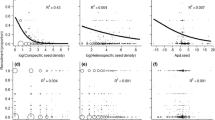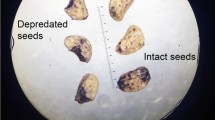Abstract
The influence of keystone consumers on community structure is frequently context-dependent; the same species plays a central organising role in some situations, but not others. On Christmas Island, in the Indian Ocean, a single species of omnivorous land crab, Gecarcoidea natalis, dominates the forest floor across intact rainforest. We hypothesised that this consumer plays a key role in regulating seedling recruitment and in controlling litter dynamics on the island, independent of the type of vegetation in which it occurred. To test this hypothesis, we conducted crab exclusion experiments in two forest types on the island and followed the dynamics of seedling recruitment and litter processing for six years. To determine if these effects were likely to be general across the island, we compared land crab densities and seedling abundance and diversity at ten sites across island rainforest. Surveys across island rainforest showed that seedlings of species susceptible to predation by land crabs are consistently rare. Abundance and diversity of these species were negatively correlated to red crab abundance. Although red land crabs may be important determinants of seedling recruitment to the overstorey, differences in overstorey and seedling composition at the sites suggests that recruitment of vulnerable trees still occurs at a temporal scale exceeding that of this study. These “windows” of recruitment may be related to infrequent events that reduce the effects of land crabs. Our results suggest that unlike the context dependence of most keystone consumers in continental systems, a single consumer, the red land crab, consistently controls the dynamics of seedling recruitment across this island rainforest.









Similar content being viewed by others
References
Adamczewska AM, Morris S (2001) Ecology and behavior of Gecarcoidea natalis, the Christmas Island red crab, during the annual breeding migration. Biol Bull 200:305–320
Asquith NM, Wright SJ, Clauss MJ (1997) Does mammal community composition control recruitment in neotropical forests? Evidence from Panama. Ecology 78:941–946
Bond W, Slingsby P (1984) Collapse of an ant-plant mutualism—the Argentine ant (Iridomyrmex humilis) and myrmechorous proteaceae. Ecology 65:1031–1037
Brown JH, Heske EJ (1990) Control of a desert-grassland transition by a keystone rodent guild. Science 250:1705–1707
Brown JH, Whitham TG, Ernest SKM, Gehring CA (2001) Complex species interactions and dynamics of ecological systems: long-term experiments. Science 293:643–650
Carlquist S (1965) Island life. Natural History Press, Garden City, NY
Christian CE (2001) Consequences of a biological invasion reveal the importance of mutualism for plant communities. Nature 413:635–639
Clarke KR, Warwick RM (1994) Change in marine communities: an approach to statistical analysis and interpretation. Natural Environment Research Council, Plymouth, UK
Coleman RA, Underwood AJ, Benedetti-Cecchi L, Aberg P, Arenas F, Arrontes J, Castro J, Hartnoll RG, Jenkins S, Paula J., Della Santina P, Hawkins J (2006) A continental scale evaluation of the role of limpet grazing on rocky shores. Oecologia 147:556–564
Condit R, Sukumar R, Hubbell SP, Foster RB (1998) Predicting population trends from size distributions: a direct test in a tropical tree community. Am Nat 152:495–509
Connell JH (1971) On the role of natural enemies in preventing competitive exclusion in some marine animals and in rain forest trees. In: den Boer PJ, Gradwell GR (eds) Dynamics of populations. Proceedings of the Advanced Study Institute on Dynamics of Numbers in Populations, Oosterbeck. Centre for Agricultural Publishing and Documentation, Wageningen, The Netherlands, pp 298–310
Denslow JS (2003) Weeds in paradise: thoughts on the invasibility of tropical islands. Ann Mo Bot Gard 90:119–127
Dirzo R, Miranda A (1991) Altered patterns of herbivory and diversity in the forest understory: a case study of the possible consequences of contemporary defaunation. In: Price PW, Lewinsohn TM, Fernandes GW, Benson WW (eds) Plant–animal interactions: evolutionary ecology in tropical and temperate regions. Wiley, New York, pp 273–287
Du Puy DJ (1993) Christmas Island. In: George AS, Orchard AE, Hewson HJ (eds) Flora of Australia vol 50: Oceanic Islands 2. Australian Government Publishing Service, Canberra, pp 1–30
Estes JA, Duggins DO (1995) Sea otters and kelp forests in Alaska—generality and variation in a community ecological paradigm. Ecol Monogr 65:75–100
Ernest SK, JH Brown (2001) Delayed compensation for missing keystone species by colonization. Science 292:101–104
Facelli JM, Pickett SA (1991) Plant litter—its dynamics and effects on plant community structure. Bot Rev 57:1–32
Green PT (1997) Red crabs in rain forest on Christmas Island, Indian Ocean: activity patterns, density and biomass. J Trop Ecol 13:17–38
Green PT (2004) Burrow dynamics of the red land crab Gecarcoidea natalis (Brachyura, Gecarcinidae) in rain forest on Christmas Island (Indian Ocean). J Crustacean Biol 24:340–349
Green PT, O’Dowd DJ, Lake PS (1997) Control of seedling recruitment by land crabs in rain forest on a remote oceanic island. Ecology 78:2474–2486
Green PT, Lake PS, O’Dowd DJ (1999) Monopolization of litter processing by a dominant land crab on a tropical oceanic island. Oecologia 119:235–244
Grubb PJ (1977) Maintenance of species richness in plant communities— importance of the regeneration niche. Biol Rev 52:107–145
Harms KE, Wright SJ, Calderón O, Hernández A, Herre EA (2000) Pervasive density-dependent recruitment enhances seedling diversity in a tropical forest. Nature 404:493–495
Hicks J (1985) The breeding behaviour and migrations of the terrestrial crab Gecarcoidea natalis (Decapoda: Brachyura). Aust J Zool 33:127–142
Hubbell SP, Foster RB (1986) Biology, chance, and history and the structure of tropical rain forest tree communities. In: Diamond J, Case TJ (eds) Community ecology. Harper & Row, New York, pp 313–330
Janzen DH (1970) Herbivores and the number of tree species in tropical forests. Am Nat 104:501–528
Jensen K, Gutekunst K (2003) Effects of litter on establishment of grassland plant species: the role of seed size and successional status. Basic Appl Ecol 4:579–587
Keddy PA (1992) Assembly and response rules—2 goals for predictive community ecology. J Veg Sci 3:157–164
Kepner JL, Robinson DH (1988) Nonparametric methods for detecting treatment effect in repeated-measures designs. J Am Stat Assoc 83:456–461
Laurance WF, Bierregaard RO (1997) Tropical forest remnants. Ecology, management, and conservation of fragmented communities. The University of Chicago Press, Chicago, IL
Leigh EG, Cosson JF, Pons JM, Forget PM (2002) How does the study of forest isolates provide better knowledge about the organization of a tropical forest? Rev Ecol-Terre Vie 8(Suppl):181–194
Lindquist ES, Carroll RC (2004) Differential seed and seedling predation by crabs: impacts on tropical coastal forest composition. Oecologia 141:661–67
McGuinness KA (1997) Dispersal, establishment and survival of Ceriops tagal propagules in a north Australian mangrove forest. Oecologia 109:80–87
McPeek MA (1998) The consequences of changing the top predator in a food web: a comparative experimental approach. Ecol Monogr 68:1–23
Menge BA, Berlow EL, Blanchette CA, Navarrete SA, Yamada SB (1994) The keystone species concept: variation in interaction strength in a rocky intertidal habitat. Ecol Monogr 64:249–286
Menge BA, Sanford E, Daley BA, Freidenburg TL, Hudson G, Lubchenco J (2002) An interhemispheric comparison of bottom-up effects on community structure: insights revealed using the comparative-experimental approach. Ecol Res 17:1–16
Mitchell BA (1975) The forest flora of Christmas Island. Commonw Forest Rev 53:19–29
Mitchell BA (1985) A vegetation survey of Christmas Island, Indian Ocean. Report to the Australian National Parks and Wildlife Service, Canberra, Australia, p 42
Molofsky J, Fisher BL (1993) Habitat and predation effects on seedling survival and growth in shade-tolerant tropical trees. Ecology 74:262–265
O’Dowd DJ, Lake PS (1989) Red crabs in rain forest, Christmas Island: removal and relocation of leaf-fall. J Trop Ecol 5:337–348
O’Dowd DJ, Lake PS (1990) Red crabs in rain forest, Christmas Island: differential herbivory of seedlings. Oikos 58:289–292
O’Dowd DJ, Lake PS (1991) Red crabs in rain forest, Christmas Island: removal and fate of fruits and seeds. J Trop Ecol 7:113–122
O’Dowd DJ, Green PT, Lake PS (2003) Invasional “meltdown” on an oceanic island. Ecol Lett 6:812–817
Paine RT (1966) Food web complexity and species diversity. Am Nat 100:65–75
Pimm SL (1991) The balance of nature: ecological issues in the conservation of species and communities. University of Chicago Press, Chicago, IL
Poff NL (1997) Landscape filters and species traits: towards mechanistic understanding and prediction in stream ecology. J N Am Benthol Soc16:391–409
Prins HHT, Vanderjeugd HP (1993) Herbivore population crashes and woodland structure in east-Africa. J Ecol 81:305–314
Quist MC, Rahel FJ, Hubert WA (2005) Hierarchical faunal filters: an approach to assessing effects of habitat and nonnative species on native fishes. Ecol Freshw Fish 14:24–39
Rilov G, Schiel DR (2006) Seascape-dependent subtidal-intertidal trophic linkages. Ecology 87:731–744
Roldan AI, Simonetti JA (2001) Plant–mammal interactions in tropical Bolivian forests with different hunting pressures. Conserv Biol 15:617–623
Scheffer M, Carpenter S, Foley JA, Folkes C, Walker B (2001) Catastrophic shifts in ecosystems. Nature 413:591–596
Sherman PM (2002) Effects of land crabs on seedling densities and distributions in a mainland neotropical rain forest. J Trop Ecol 18:67–89
Silman MR, Terborgh J, Kiltie RA (2003) Population regulation of a dominant rain forest tree by a major seed predator. Ecology 84:431–438
Smith TJ, Chan HT, McIvor CC, Robblee MB (1989) Comparisons of seed predation in tropical, tidal forests from three continents. Ecology 70:146–151
Terborgh J, Wright SJ (1994) Effects of mammalian herbivores on plant recruitment in two neotropical forests. Ecology 75:1829–1833
Terborgh J, Lopez L, Nunez P, Rao N, Shahabuddin G, Orihuela G, Riveros M, Ascanio R, Adler GH, Lambert TD, Balbas L (2001) Ecological meltdown in predator-free forest fragments. Science 294:1923–1926
Vitousek PM (2002) Oceanic islands as model systems for ecological studies. J Biogeogr 29:573–582
Warner RR, Chesson PL (1985) Coexistence mediated by recruitment fluctuations: a field guide to the storage effect. Am Nat 125:769–787
Whittaker RJ, Jones SH, Partomihardjo T (1997) The rebuilding of an isolated rain forest assemblage: how disharmonic is the flora of Krakatau? Biodivers Conserv 6:1671–1696
Wright SJ (2002) Plant diversity in tropical forests: a review of mechanisms of species coexistence. Oecologia 130:1–14
Wright SJ, Zeballos H, Dominquez I, Gallardo MM, Moreno M, Ibanez R (2000) Poachers alter mammal abundance, seed dispersal, and seed predation in a tropical forest. Conserv Biol 14:227–239
Wyatt JL, Silman MR (2004) Distance-dependence in two Amazonian palms: effects of spatial and temporal variation in seed predator communities. Oecologia 140:26–35
Acknowledgments
This study was funded by Environment Australia and the Australian Research Council. S. Gerrard, D. Metcalfe and D. Wallace assisted in the field. We are especially grateful to M. Campbell and K. bin Arshad for their friendship and unstinting hospitality over the years. The work described here was conducted under relevant permits in the Christmas Island National Park. We dedicate this paper to the memory of Holger Rumpff, fellow island naturalist and terrific friend. This is contribution no. 148 from the Australian Centre for Biodiversity, School of Biological Sciences, Monash University.
Author information
Authors and Affiliations
Corresponding author
Additional information
Communicated by John Silander.
Rights and permissions
About this article
Cite this article
Green, P.T., O’Dowd, D.J. & Lake, P.S. Recruitment dynamics in a rainforest seedling community: context-independent impact of a keystone consumer. Oecologia 156, 373–385 (2008). https://doi.org/10.1007/s00442-008-0992-3
Received:
Accepted:
Published:
Issue Date:
DOI: https://doi.org/10.1007/s00442-008-0992-3




